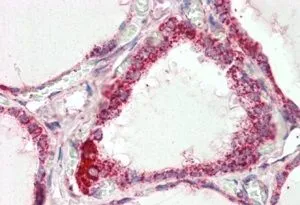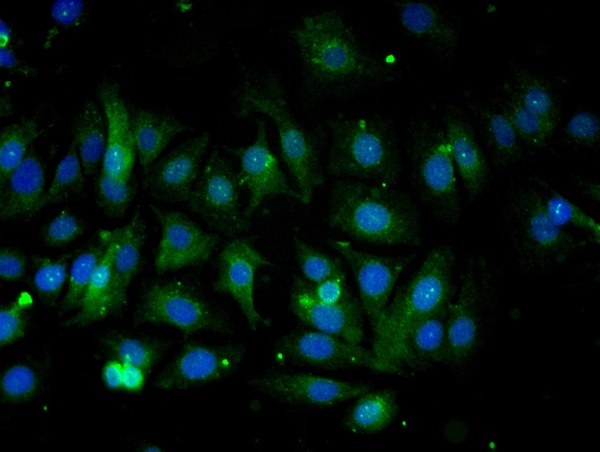
WB analysis of human muscle lysate using GTX88987 COX4I1 antibody, C-term. Dilution : 0.01microg/ml Loading : 35microg protein in RIPA buffer
COX4I1 antibody, C-term
GTX88987
ApplicationsWestern Blot, ImmunoHistoChemistry, ImmunoHistoChemistry Paraffin
Product group Antibodies
TargetCOX4I1
Overview
- SupplierGeneTex
- Product NameCOX4I1 antibody, C-term
- Delivery Days Customer7
- Application Supplier NoteWB: 0.01-0.03microg/ml. IHC-P: 2-4microg/ml. *Optimal dilutions/concentrations should be determined by the researcher.Not tested in other applications.
- ApplicationsWestern Blot, ImmunoHistoChemistry, ImmunoHistoChemistry Paraffin
- CertificationResearch Use Only
- ClonalityPolyclonal
- Concentration0.50 mg/ml
- ConjugateUnconjugated
- Gene ID1327
- Target nameCOX4I1
- Target descriptioncytochrome c oxidase subunit 4I1
- Target synonymsCOX IV-1, COX4, COX4-1, COXIV, COXIV-1, MC4DN16, cytochrome c oxidase subunit 4 isoform 1, mitochondrial, cytochrome c oxidase polypeptide IV, cytochrome c oxidase subunit IV
- HostGoat
- IsotypeIgG
- Scientific DescriptionCytochrome c oxidase (COX) is the terminal enzyme of the mitochondrial respiratory chain. It is a multi-subunit enzyme complex that couples the transfer of electrons from cytochrome c to molecular oxygen and contributes to a proton electrochemical gradient across the inner mitochondrial membrane. The complex consists of 13 mitochondrial- and nuclear-encoded subunits. The mitochondrially-encoded subunits perform the electron transfer and proton pumping activities. The functions of the nuclear-encoded subunits are unknown but they may play a role in the regulation and assembly of the complex. This gene encodes the nuclear-encoded subunit IV isoform 1 of the human mitochondrial respiratory chain enzyme. It is located at the 3 of the NOC4 (neighbor of COX4) gene in a head-to-head orientation, and shares a promoter with it. [provided by RefSeq, Jul 2008]
- Storage Instruction-20°C or -80°C,2°C to 8°C
- UNSPSC12352203







![FACS analysis of K562 cells using GTX82782 COX4 antibody [6B3]. Blue : COX4 Red : negative control](https://www.genetex.com/upload/website/prouct_img/normal/GTX82782/GTX82782_20170912_FACS_w_23061322_816.webp)